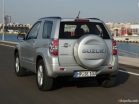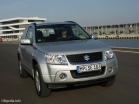Suzuki Grand Vitara 3 Drive Test drive since 2010 SUV
From each - by abilities
Parners are now in fashion. You must admit that relatively small dimensions, a universal salon, all -wheel drive and, finally, a decent road clearance make such machines almost the most suitable for our latitudes and lifestyle.Toyota-RAV4 of two generations has always been in the leaders of this class. Suzuki Grand Vitara was especially appreciated by those who occasionally nevertheless moved from the asphalt. Today on the sale of a new generation model. Has the alignment of strength changed?
 IN THE CABIN
IN THE CABIN The appearance of the Grand Vitara in a nutshell: strict, but elegant. Which side you will not come a single extra element: a green suit sits on the units, like a uniform on a fit officer. And if you put Rav4 nearby? The blue dress is tailored in the latest fashion, the eyelashes of the headlights skillfully let the bride and groom are skilled, and nothing more!
The dimensions of the cars are almost the same. Suzuki is a little longer, already lower, but the difference is insignificant. Inside Toyota, only on the iot is more spacious at the elbows. The feeling of space in it is also emphasized by plastic: in the Grand Vitara it is coal-black and very tough. Even catchy inserts for aluminum do not help, the car is perceived too stiff. There are almost no complaints about ergonomics, except that the seat pillow could be more authentic, and the side support is larger. Huge devices, hidden in three wells, are read well. Perhaps only a review through the salon mirror leaves much to be desired. As if catching up, the designers decided to atone for the guilt with huge external mirrors, in which you can’t only see yourself.
The manufacturer's data expert evaluation of cars Welcome to RAV with this inscription on the Toyota route computer responds to the key turn in the ignition lock. Perhaps on the ice road this is the following reminder on the screen. I wonder how I guessed, we have not yet moved oh yes! On the panel, the temperature overboard is displayed. Perhaps the greeting and reminders do not bear much benefit. But when the Japanese car addresses you in Russian is very pleasant!
The materials in the Toyota salon are a little bit, but better: the plastic is also hard, but the color looks not so radical. Above the main mess, a box for the little things sheltered, covered with a curtain, like a breadbuminess. This cache opens and closes with pressing the button, and the bottom is covered with a soft carpet. Small things again, but pleasant again!
At the wheel of the Rafi, I liked more, although the chair is soft. But lateral support here is more noticeable, and a wide range of adjustments will conveniently sit down to both the fragile girl and the tall man.
The dimensions of the car are still nearby colleagues, you need to use it. Putting the front seat under my 180 cm, the three of us jump back. The Grand is subjectively more open over the heads of the side passengers, but there is almost no reserve for the knees. In Toyota is more comfortable. The tunnel on the floor protrudes only a couple of centimeters, practically equalizing in the rights of the average passenger with neighbors. In addition, the seats of the second row can be shifted back, which significantly adds comfort (of course, due to the trunk).
Both machines allow you to transform the configuration of the cabin. Parts of the rear sofa in Toyota can not only move, but also change the angle of inclination of the backs or fold them. Under the floor of a couple of deep comfortable niches for tools and small things. In the Suzuki, the underput is much smaller, and the rear seats are motionless.
To solve the outcome of the battle of trunk, they measured their volumes in a five -seater configuration. They coincided with an accuracy to a liter!
IN THE TOWN
That's what Chevrolet Niva should have turned out! This thought pursued me, it was worth starting the engine. The motor in Suzuki at idle is heard, small vibrations come to the gearbox lever. It was worth touching the pedals, they felt their male character: they were rather heavy, of course, by passing standards. In addition, in motion (for some reason, especially in second gear), the work of the transmission is slightly audible. However, everything works clearly and harmoniously. Acceleration is rather sluggish. The engine of 140 forces is clearly not for lovers to break out of the stream. Oddly enough, with a flat characteristic and unwillingness to spin the bottom of the motor, it is also very mediocre: at a speed of 70 km/h on the fourth gear of Suzuki, two adults in a small slope almost without accelerating even with a completely open throttle.
Our copy is without a stabilization system, so you can easily feel the nuances of controllability. Grand Vitara willingly dies into a turn, while the cranes of the body are small. If you overdo it with the speed of entering the turn, the car begins to smoothly slide to the outer edge of the turn, but easily returns to the given path, it is worth correcting the course with the steering wheel and gas pedal. At a speed of more than 90 km/h, the Grand Vitara becomes noisy: the wind whistles outside the window, the motor is buzzing, but the tires are most annoyed.
In fairness: the test car is shifted to the studded Cooper Discoverer. Passing ice and snowy areas at cruising speed, Suzuki pretty shakes the riders, and the suspension is transferred to the body with annoying vibrations.
After Suzuki, the Toyota pedal seems weightless, the steering wheel can be twisted with one finger, and the box lever seems toy. If Vitara is perceived as a male alternate, then RAV is closer to a light car. Toyota quieter Suzuki in all modes sometimes you will not immediately understand whether the engine works. The motor reminds of itself only with energetic acceleration. By the way, there was a feeling that oil with fantastic lubricating characteristics splashes in the RAV engine crankcase, its engine is so quickly and easily twisted compared to Suzuki. But in terms of power, the Toyota engine is only 12 forces in front, and the equipped mass is not much.
On the speedometer 80 km/h, under the wheels snow with ice. A smooth turn and an exaggeratedly large angle of rotation of the steering wheel. The back axis begins to swim, but after a moment Toyota is already cracking with electronics. Despite the pressed gas pedal, the engine speed falls, the steering wheel begins to resist the unreasonable driver, and the car, slowing down, is leveled. This is how the Integrated Active Drive System works, combining the steering wheel, the device of traction control, stabilization and ABS. Electronics can be redistributed between the axes, slow down any of the wheels and even independently turn the steering wheel to the right angle!
Over and over, trying to force Toyota to go through a turn in a lateral sliding, came across the same result: trr-r some somewhere from the back to the left, pr-r-r-r-rf front, and now we are going straight again! Of course, among lovers to put snow or sand dust in the eyes of the stabilization system can cause irritation. But she provides great assistance to the ordinary driver.
 IN FIELD
IN FIELD This year there was almost twice as many normal: it's time to see how cars behave without parquet. But first, an inspection from below. There is no obvious winner. In Vitara, the road clearance is limited by the back of the muffler 180 mm, the lowest point in Toyota is the rear racks of the stabilizer 185 mm. Serious boilers are contraindicated both: there is no steel protection of the motor compartment, there are aerodynamic shields under the front bumper, which which are minute to tear.
The transmission in the new Grand Vitara has undergone significant changes. The previous generation had a rigidly connected front bridge, and there was no center differential. The all -wheel drive mode was intended only for off -road, the rear wheels were brought on the asphalt. Now the permanent drive is full, the distribution of the moment between the axes is equal. You can block the inter -long differential and enable the reduced series of transmission.
Toyota under ordinary conditions is front -wheel drive. The front wheels will begin to slip the rear axle, to which is transmitted to 45% of the moment. The driver is able to only block the center differential (its role is played by an electromagnetic coupling) with a button to the right of the steering wheel.
So the case introduced himself: from the main road, an unclean path dotted with hillocks leads to the forest. The first crawls Suzuki. On a reduced gear, the motor without visible efforts pulls out a car from quite slippery in the literal and figurative sense of situations. We were not even afraid to stop for photography. Grand calmly removed from the anchor and moved on the way back.
Well, what about Rav? With a blocked differential, Toyota zealously breaks into battle and soon begins to smell of a faded clutch. Without a reduced series, it is difficult for her to compete with Suzuki lacks a moment at low speed. We have to play with a clutch, preventing the motor from stall. But where Suzuki went, Toyota also did not give up. And we complicate the task, the sacrifice, probably, would have to make a plastic body kit and muffler
As before, cars are addressed a little different audience. Although Suzuki Grand Vitara became more comfortable on the asphalt, its main advantage is more serious all -wheel drive. This allows you to leave the parquet away than on most classmates. The element of Toyota is a city, albeit a snowy, or suburban highway. It is quieter, more dynamic and certainly more suitable for girls thanks to delicate pedals and light steering wheel. Well, from everyone according to his abilities!
Suzuki Grand Vitara
Suzuki Grand Vitara was represented under the name Eskudo in Japan in 2005, the European version made his debut in Frankfurt a few months later.
Engines: gasoline 1.6 and 2.0 liters (106 and 140 hp).
Gearboxes: 5-speed mechanical, 4-speed automatic.
Price: $ 29 30035 130.
Suzuki Grand Vitara Suzuki Grand Vitara trunk Granda is not inferior in volume to Toyota, but the seats are folded differently. Grand Vitara: successful design, impeccable assembly and not the best plastics.
The console Grand Vitara is laconic, ergonomics at a height. In this configuration, music is not provided. Behind Grand Vitara is not very comfortable to the knees of tall passengers. Suzuki’s transmission modes are now headed by a rotary handle.
Suzuki Grand Vitara successfully enters the niche between a serious full -size all -terrain vehicle and an all -wheel drive car. Good price/quality ratio.
General assessment 7.7
+ Balanced appearance, high assembly quality, excellent for the SUV SUV, understandable handling, attractive price.
- A rather high noise level, not enough powerful engine, large moves of the gearbox lever, not the best decoration materials.
Toyota Rav4
Toyota-Rav4 debuted at the Frankfurt car dealership in 2005.
Engines: 2.0 l (152 hp).
Gearboxes:
5-speed mechanical, 4-speed automatic.
Price: $ 33,00037 800.
Toyota Rav4 Toyota Rav4 in Rav4 a deep underput, as well as a grid on the door of the trunk. Connection of the lock in Toyota occurs at speeds up to 40 km/h.
In Toyota, the seats move back and forth, the tunnel on the floor practically does not interfere. Toyota pleased with an effective climate installation with separate adjustment for the driver and passenger. Toyota salon is more comfortable, and materials are more expensive. Even plastic aluminum on the panel here is somehow colder to the touch than in Suzuki.
Toyota RAV4 convenient, comfortable, truly universal car. A little biting price is due not only to the authority of the brand, but also by the high quality of the finishes. A worthy level of comfort.
General assessment 8.3
+ Acoustic comfort, a dynamic engine, an excellent climatic installation, a successful stabilization system, a Russified menu, rich possibilities for transformation of the salon.
- limited possibilities outside the asphalt, not the most expressive appearance, a rather high price.
Mikhail Gzovsky: Susuki off -road abilities are higher, but the victory of Toyota brought passenger qualities.












Source: The magazine "Driving"




